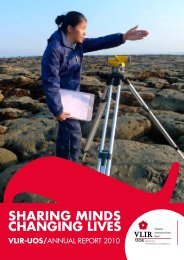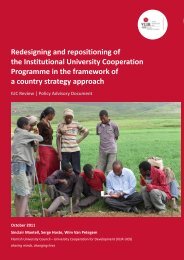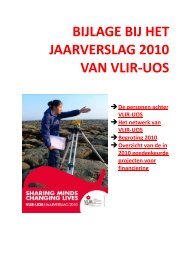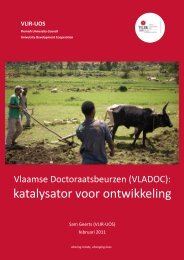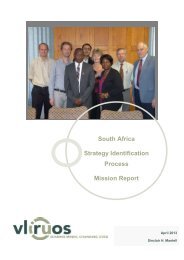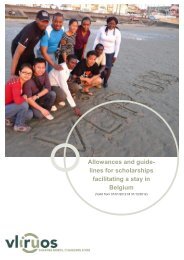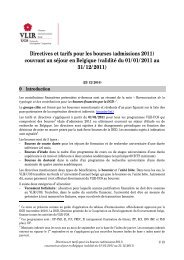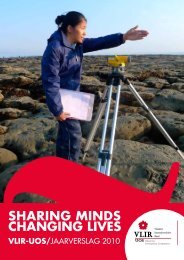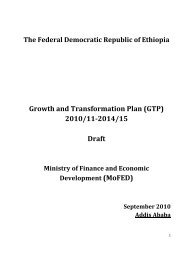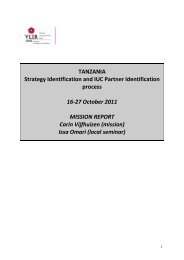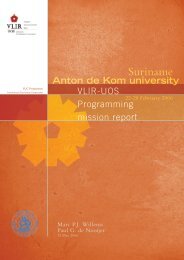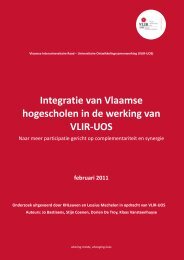Education Sector Development Program - VLIR-UOS
Education Sector Development Program - VLIR-UOS
Education Sector Development Program - VLIR-UOS
You also want an ePaper? Increase the reach of your titles
YUMPU automatically turns print PDFs into web optimized ePapers that Google loves.
<strong>Education</strong> <strong>Sector</strong> <strong>Development</strong> <strong>Program</strong> IV<br />
Quality of Primary and Secondary education<br />
(including ABE)<br />
The objectives and strategies for the quality<br />
improvement of general education during the<br />
forthcoming years have been clearly spelled<br />
out by the MoE in the General <strong>Education</strong> Quality<br />
Improvement Package (GEQIP). The package<br />
is composed of a number of components and<br />
sub-components which are complementary to<br />
each other and form part of an integrated school<br />
effectiveness model. The presentation hereafter<br />
is structured around several components<br />
of the package, namely the development of<br />
teachers and leaders; curriculum, textbooks and<br />
assessment; planning of school improvement<br />
and of resource use by schools; the use of<br />
Information and Communications Technology<br />
(ICT). One component has been added and relates<br />
to the improvement of school infrastructure<br />
and facilities, with special attention to the most<br />
remote regions. Another GEQIP component,<br />
namely the Management and Administration<br />
<strong>Program</strong> (MAP) is more closely related with the<br />
management of the educational system as a<br />
whole and has therefore been integrated into the<br />
crosscutting issue on capacity development.<br />
Each of these components has its own program<br />
outcomes and targets. Two major outcomes are<br />
common to all five components because of their<br />
supreme importance. Firstly, the imperative to<br />
bring down urgently the drop-out rates in the<br />
early grades: the high levels of drop-out are to a<br />
large extent an expression of the poor quality and<br />
attractiveness of schools; as long as these rates<br />
remain high, the objective of Universal Primary<br />
<strong>Education</strong> will not be achieved. Secondly, the<br />
need to translate the investments made in<br />
improving the inputs into the school system (such<br />
as better teacher training, more equipment and<br />
textbooks) into stronger student achievement.<br />
One central finding of ESDP III implementation<br />
was precisely that student achievement remained<br />
low notwithstanding significant ameliorations<br />
in teacher qualifications and training and in<br />
equipment (see Table hereunder).<br />
Evolution of scores obtained in National<br />
Assessment of Student Achievement<br />
1. Situation analysis<br />
The situation analysis briefly examines progress<br />
related to quality improvement under ESDP III.<br />
Where relevant, it comments in particular on<br />
progress since the introduction of GEQIP.<br />
Concerning teachers’ and leaders’<br />
development<br />
An impressive number of teachers<br />
were recruited during ESDP III. Their<br />
total number in primary and secondary<br />
education went up from 171,079 (60,902<br />
women) in 2004/05 to 270,594 (100,680<br />
women) in 2008/2009.<br />
A Teacher <strong>Development</strong> <strong>Program</strong> was<br />
launched in order to improve teacher<br />
qualifications and professional development.<br />
The plan covered the period 2004/05- 2006/07<br />
and was later on extended through the year<br />
2007/08. Amongst the major achievements of this<br />
program, the following are worth mentioning:<br />
❚<br />
❚<br />
❚<br />
❚<br />
The required qualification level of<br />
primary school teachers has been<br />
increased from a 1 year certificate<br />
course to a three year diploma course<br />
after grade 10, while requirements<br />
for the training of secondary school<br />
teachers have been changed from an<br />
education bachelor degree course to<br />
a degree course in a major field plus<br />
one year add-on professional teacher<br />
training.<br />
A special practicum program was<br />
introduced in pre-service teacher<br />
training.<br />
A curriculum revision has been<br />
undertaken to adapt the different<br />
teacher training curricula to the new<br />
teacher qualification requirements.<br />
An English Language Improvement<br />
<strong>Program</strong> (ELIP) was established from<br />
which more than 150 000 teachers<br />
have already benefitted, while English<br />
Language Improvement Centers<br />
(ELICs) were set up at some TEIs.<br />
The objectives and<br />
strategies for the<br />
quality improvement of<br />
general education during<br />
the forthcoming years<br />
have been clearly spelled<br />
out by the MoE in the<br />
General <strong>Education</strong><br />
Quality Improvement<br />
Package (GEQIP).<br />
2000/01 2004/05 2007/08<br />
Grade 4<br />
Composite score* 47.9% 48.5% 40.9%<br />
Grade 8<br />
Composite score** 41.1% 39.7% 35.6%<br />
*Composite score of Math Reading and English ( reading test reported to have changed considerably since<br />
2004/05 test)<br />
** English and Math, but including also Biology, Chemistry and Physics results<br />
19



